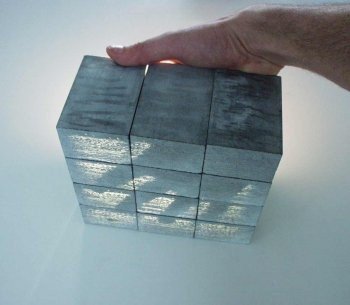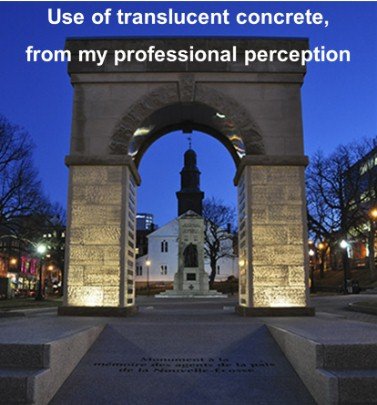The study of the behavior of materials has always been present in the technical decisions and recommendations that I usually resolve in my day-to-day.
One of the materials that some clients have asked me about is about the possibility of using translucent concrete, which is not marketed in Venezuela, but could be imported for a specific purpose.
Translucent concrete is conceived as the combination of a binder that is the cementing material, fine / coarse aggregates, water and an additive in this case fibers of polymeric origin, which give it that translucent characteristic.
Within the evolution of this novel material, two great “rivals” stand out, the first of them is a concrete patented in Mexico by Sergio Omar Galván and Joel Sosa commercially called ILUM 1 in Mexico, and the other case is LITRACON 2 created by Áron Losonczi in Hungary. In both cases, it is highlighted that these two versions of translucent concrete are not completely transparent, in fact they only allow the passage of light when there is a “great source of light”, but their use is still attractive.

Customer perspective Vs. reality
Here we go, the client who asks me, wishes to use the "translucent concrete" in the construction of what will be "his summer house" here in my city, a beautiful house "on the water" worth noting. This person has the idea of using translucent concrete in the structure to create a great aesthetic and striking impact.
The idea alone seems attractive to me, but it would be unprofessional for me to take the idea from it on a subject that has neither head nor tail from a constructive point of view, because there are more myths than realities involved, and I would say that there are a lot of misleading advertising too.
Translucent concrete is a good product, it is a good invention, but we must know how to use it and we must be clear that its use is not structural, it is only to be used in aspects where aesthetics is the fundamental premise.

Why yes and why not?
If we see the way the translucent concrete is constituted, we find that a binder is used which is generally white cement, the corresponding aggregates, water and with this is the basic recipe, but polymeric fibers (plastics or fiber optic chips) are included for that the material is almost transparent, so far we are going well. But if we intend to use it as a structural element, let's say to build structural elements (beams and columns), it is mandatory to think about the inclusion of steel reinforcement bars, and who wants to see the bars of the beams and columns of your house? Secondly, it was not created for structural use despite the fact that the tests showed that compressive strengths greater than 500 Kg/cm2 are achieved (and this depends on the proportions of the materials of the basic recipe).
In any case, the feasibility of its use in structural elements has been widely discussed, it would be appropriate to open a line of research to this proposal, since in these cases the only variable that determines its feasibility of use in structural systems is not Resistance to Compression of Concrete.
It is important to take into account that structural systems during their" operation "experience different efforts such as; compression, flexion, traction, among others.
But this aspect is not a reason to rule out the use of translucent concrete in masonry, as facade walls or internal walls, since these do not have "any structural responsibility" in the behavior of a building, they are just "masonry".

Translucent Concrete block. Image Resource

What advantages can the use of translucent concrete blocks offer?
There are many aesthetic and functional advantages that we can find to be perfectly used in masonry elements, such as aesthetic walls and facades, such as:
- The passage of light, although only in a very low percentage, is still attractive, it should be noted that they are not totally transparent, due to the color of the cementitious material and the aggregates.
- Lightweight, because its volumetric weight can be up to 30 times less than conventional concrete. This is due to the fact that in its composition the fibers of polymeric origin can represent 80%.
- Resists high temperatures.
Before closing the post, it is worth mentioning three major disadvantages that I find as a construction professional: 1) this concrete is very expensive compared to conventional concrete; 2) there is no national (in Venezuela) or international regulation that defines and regulates its use as structural material; 3) In addition to this, its use for the construction of complex structural systems (beam and column frames, slabs, etc.) is not regulated either, so this use is not feasible until now, and it is because this aspect is still in experimental phase.
Close
Not always what they sell us as a great technological advance or novelty is entirely feasible, although the translucent concrete use is a first since approximately 2001 when some patents came out, I personally am very careful when making recommendations and accepting their use in engineering projects.
I do not refuse to use it, but I like to be very clear with clients who can project and explain to them down to the smallest detail.
But I know that we all would like to have attractive translucent walls at home as a special attraction, right?
Give me your opinion about it..!
"All the text has been written according to my professional experience as an engineer, university professor, researcher and developer of engineering projects."











Hello friend, the truth a great information, I had no idea about all that, but for the benefits you tell us can be a great option. Obviously in our country now is almost impossible to buy something that is not with a high price and more with great advantages. Greetings and thanks for sharing.
Hello @franyeligonzalez, I think that for now in Venezuela it is a very expensive option because it must be imported, but it is not impossible at all, in fact many of my students are experimenting with creating concrete blocks with different types of polymeric materials.
Thanks for comment
Greetings my friend @tocho2,
Worthy of any professional to give the pros and cons of the areas in which we are experts. In this particular, although I am not an expert in the area, I agree with what you express about this type of materials, since one thing is aesthetics and another very different thing is the support of a construction, where the materials must be of better quality and that supports the passing of the years. Thank you for your great contribution
Hello @madridbg,
You are right to mention the difference between the aesthetic appeal of a material and its functionality from a structural point of view, we must always be honest with customers to avoid problems in the future.
Thanks for comment..!
i personally knew of the existence of concrete that allows the rapid passage of water and of concrete resistant to explosions (this is in development in iran) but i did not know of the existence of a translucent cement, excellent information.
Hello @trabajosdelsiglo, rather I thank you for informing me about the concrete that resists explosions, I will investigate the matter.
See you soon